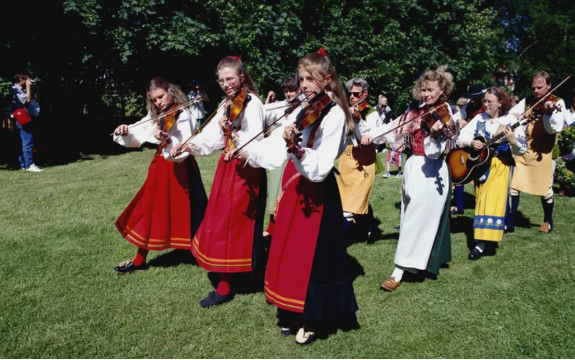
Have you ever heard any German folk songs? We invite you to listen to them, learn them, and yes, even sing them — even if your attempt is only in the shower. You’d be surprised at how rich the imagery can be in certain folk songs and how they offer a glimpse into German culture. It has been proven countless times that music can accelerate language learning, so why not take the plunge?
Der Mond ist Aufgegangen
This German folksong is extremely popular. It is sung by children, performed at church, and almost always heard when German folk songs are sung. It is a highly versatile song for teaching German. The first verse is best suited for beginners, while the other verses are more appropriate for intermediate students. Additionally, it is an excellent song for discussing symbolism and religion. This is a favorite folk song among teachers for introducing bird names — fourteen in total! Moreover, wedding vocabulary can be learned as the birds in the song celebrate a marriage.
Sah ein Knab ein Rӧslein stehn
This folk song serves as a good introduction to Goethe for advanced beginners. Written by Goethe in 1799, the poem “Heideröslein” has been set to music by multiple composers. The version sung today was composed by Schubert. A lesson on rhyme and symbolism can be presented through this song.
Im Frühtau zu Berge
Many Germans would be surprised to learn that this popular folk song originally hails from Sweden. It was translated into German in the early 20th century and immediately became a favorite “Wanderlied”, remaining so ever since. There have even been funny versions of this song, such as “Beim Frühstück am Morgen sie sehn” and “Im Frühstau bei Herne wir blühen richtig auf.”
Grün, Grün, Grün
Today, this is regarded more as a children’s song sung in primary grades. However, in the 19th century, it was known as a dancing folk song. This song is perfect for learning colors and job titles simultaneously. What I like most about this song is that you can insert your own color into the song, along with the accompanying job title associated with it.
原创编写 版权所有 侵权必究! 每日更新 个性化阅读 英语飙升!
1.1. The underlined word “versatile” in Paragraph 2 probably means ______.
A simple in tune
B various in length
C flexible in response
D diverse in use
解析:选D。D 词义猜测题。根据后文“The first verse is best suited for beginners, while the other verses are more appropriate for intermediate students. Additionally, it is an excellent song for discussing symbolism and religion.”可知,这首歌适合不同水平学生,还能用于多种教学,可知它功能全面。所以versatile意思是“多用途的;多功能的”。故选D。
2.2. Why might “Sah ein Knab ein Rӧslein stehn” be used for advanced beginners?
A It focuses on basic color names.
B It introduces Goethe’s literary works.
C It contains humorous wedding scenes.
D It requires no knowledge of symbolism.
解析:选B。B 推理判断题。文中提到该歌曲可作为”introduction to Goethe”,并涉及诗歌韵律和象征主义。选项B符合逻辑推理,而选项A(颜色)和C(婚礼)属于其他歌曲内容,属于张冠李戴。故选B。
3.3. Why did “Im Frühtau zu Berge” surprise Germans?
A Its sudden appearance.
B Unexpected Swedish origin.
C Complicated dance moves.
D Religious symbolism.
解析:选B。B 推理判断题。第四段首句明确提到“Many Germans would be surprised... originally hails from Sweden”,直接对应瑞典起源的意外性。故选B。
4.4. What does “Grün, Grün, Grün” mainly focus on?
A Combining colors with jobs.
B Preserving Swedish traditions.
C Developing singing techniques.
D Documenting wedding customs.
解析:选A。A 段落大意题。第五段明确指出该歌曲“perfect for learning colors and job titles simultaneously”,且允许自定义颜色与职业搭配。故选A。
